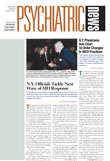Almost from the moment the planes crashed into the World Trade Center and the Pentagon, members of the Washington Psychiatric Society (WPS) recognized that they had a special challenge in defining their role in the weeks ahead.
Although devastating, the immediate loss of life at the Pentagon was considerably less severe than at the World Trade Center. In addition, the various branches of the military had already developed sophisticated procedures for responding to disasters, which they quickly implemented at the Pentagon. Those procedures did not readily lend themselves to the use of volunteers (see next issue of Psychiatric News).
Members of the general population of the Washington, D.C., area, however, remain very aware that as residents of the nation’s capital, they will be at continued risk in the event of another terrorist attack or sustained hostilities.
Catherine Stuart May, M.D., WPS president-elect said, “Certainly more people are seeking assistance from psychiatrists. Former patients are returning, and we are getting calls from new patients. Chronically ill patients are responding to the general level of anxiety in the area by becoming more symptomatic.”
The Washington Post reported that physicians are seeing an increase in the number of patients reporting exacerbation of symptoms of physical pain.
Jim Dee, M.D., WPS president, said, “This is going to be a long-term problem.” The WPS executive committee put together a disaster response committee consisting of Dee, May, Judith Nowak, M.D., Lou Kopolow, M.D., and Harold Eist, M.D. The goal of the group was to develop a plan to meet the needs that would surface in the weeks and months ahead and to prepare for the eventuality that disaster might hit Washington, D.C., again. Appropriate training was a key element of that plan.
The WPS asked Michael Hollifield, M.D., an assistant professor of psychiatry and family medicine at the University of New Mexico (UNM), to offer its members intensive training that would enable them to provide free group therapy sessions to area residents who are at high risk for chronic posttraumatic stress disorder (PTSD) and other mental health problems resulting from the attacks. The training is funded through a grant for $10,000 from APA through its Erich Lindemann Disaster Grant Program.
For the last seven years, Hollifield has directed the Special Problems and Behavioral Medicine Clinic at UNM Medical School, which offers special expertise in cognitive restructuring therapy for trauma survivors. He is a member of the Disaster Medical Assistance Team in New Mexico, under the auspices of the Department of Health and Human Services.
The training is funded through a grant for $10,000 from APA through its Erich Lindemann Disaster Grant Program.
A full-day training session was offered on October 13 to WPS members who agreed to offer their services pro bono for the group therapy sessions. Residents from the George Washington University department of psychiatry received a half-day of training on October 14.
The program got under way when WPS publicized a hot-line phone number to which anyone in the geographic area experiencing stress about the attack could call. Psychiatry residents from George Washington University answered the phones, asked a series of questions that enabled them to assess degree of risk for PTSD, and referred callers to appropriate resources. Those with the most severe level of risk were offered opportunities for free group therapy sessions.
Hollifield said, “Every caller received an appropriate referral, even though we did not have resources to offer everyone free therapy.”
Each group was scheduled to meet for five consecutive days in late October. In addition to their time, participating psychiatrists also volunteered their office space. Hollifield said, “All participants in the group therapy sessions will be offered follow-up resources.”
The WPS has seen a tenfold increase in the number of hits to its Web site at www.dcpsych.org. Psychiatrists and other physicians can take a self-directed course on the site about PTSD, based on a CME program previously offered by the society. The site also offers the Kopolow Trauma Scale. ▪
